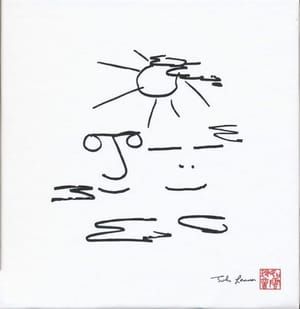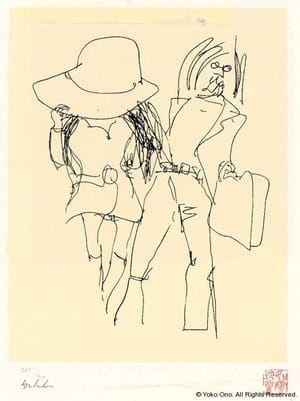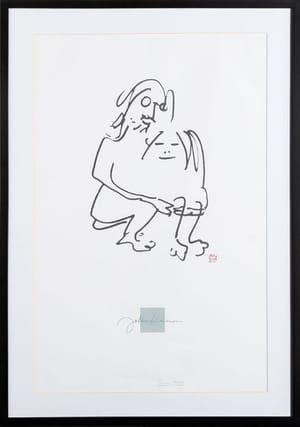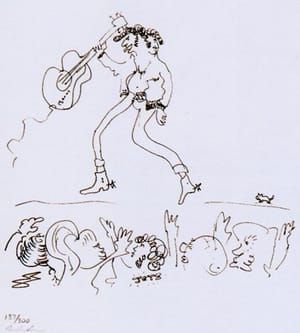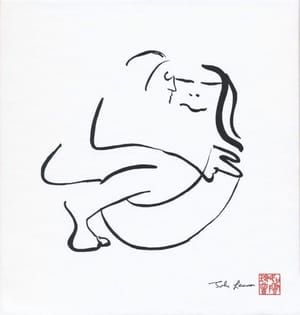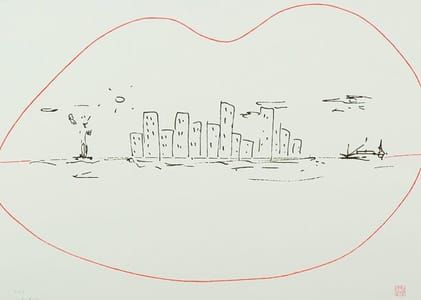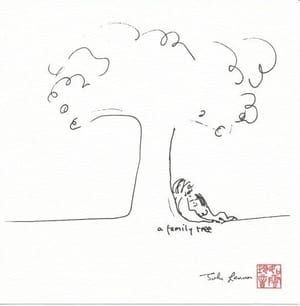

Untitled
John Lennon
In 1968 Anthony Fawcett, a friend of John Lennon’s who later became one of the employees of Apple Records, proposed lithography to Lennon as an area that might spark his artistic interest. Lennon was initially reluctant, as the relatively time-consuming methods that were involved ran counter to the “impulsive” approach that Fawcett perceived as Lennon’s preference. Fawcett came up with a couple of hacks that would enable the lithography process to be more like Lennon’s usual facility at doodling and sketching.
Several months passed, and Fawcett assumed that Lennon had forgotten all about the subject. But when Lennon and his new bride Yoko Ono returned from Europe after the week-long Bed-In for Peace in the spring 1969 it turned out that Lennon had gotten more interested in the process. As Fawcett wrote in his 1976 memoir John Lennon: One Day at Time, Lennon “had made a series of drawings of the marriage and honeymoon, and was now anxious to see how they would look as lithographs. ... Yoko was the main subject, there were many portraits and nudes of her.”
When he saw them John was ecstatic, oohing and ahhing with childlike enthusiasm, laughing, wildly gesticulating and obviously impressed at the results. He seemed thrilled by the new dimension his drawings had taken on, master-printed on the thick luxurious Arches paper. Yoko, too, was excited for John and watched his exuberance with a kind of motherly pride.
A plan was concocted to sell some of the lithographs in a limited-edition set. The set would be titled Bag One, a reference to John and Yoko’s theory of “Bagism” which prevailed at the time. Peter Doggett in The Art and Music of John Lennon has this to say about the project:
"The drawings were converted from Lennon’s small originals to poster size, organised into limited edition packages, and given to John so he could sign each lithograph. They were then placed inside special Bag One folders, and sold to art-minded (and rich) individuals around the world. It might have been more in keeping with Lennon’s principles if they’d been issued as postcards instead."
In the event, Lennon was obliged to sign 3000 posters, which he did at the Toronto-area farmhouse of Ronnie Hawkins.
In January 1970 the lithographs were displayed at an exhibition in London. The authorities, however, were not amused. As Fawcett writes,
"Inevitably, on the second day of the exhibition, the police raided the gallery with a warrant, supposedly after Scotland Yard had received complaints, and eight of the lithographs were confiscated. The summons alleged that the gallery had “exhibited to public view 8 indecent prints to the annoyance of passengers, contrary to Section 54(12) of the Metropolitan Police Act, 1839, and the third schedule of the Criminal Justice Act 1967."
In January 1970. the magazine Avant Garde published what they termed “John Lennon’s Erotic Lithographs,” being a subset of the Bag One set. This post features the full magazine spread of that issue. You can see the full issue of Avant Garde here; vintage issues can be purchased at Amazon as well.
Avant Garde’s cheeky intro compares John and Yoko to other “famous couples in history” such as Dick and Pat Nixon, noting that we must exercise our imaginations to envision them in the act of lovemaking. Not so with John and Yoko!
(http://dangerousminds.net/comments/the_erotic_lithographs_of_john_lennon_nsfw)
© John Lennon
John Lennon
artistArthur
coming soon

